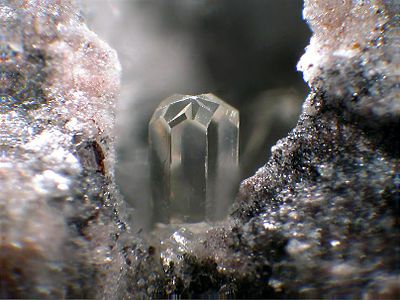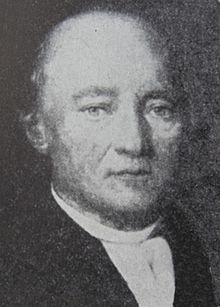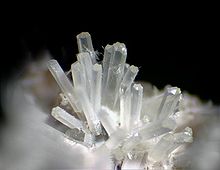Nosean
| Nosean | |
|---|---|
| Nosean single crystal (1 mm) with a typical head shape made from tub heads near Ochtendung in the Eifel | |
| General and classification | |
| other names |
Spinellan |
| chemical formula |
|
|
Mineral class (and possibly department) |
Silicates and Germanates |
|
System no. to Strunz and to Dana |
9.FB.10 ( 8th edition : VIII / J.11) 76.02.03.02 |
| Crystallographic Data | |
| Crystal system | cubic |
| Crystal class ; symbol | cubic-hexakistrahedral; 4 3 m |
| Room group (no.) | P 4 3 n (No. 218) |
| Lattice parameters | a = 9.08 Å |
| Formula units | Z = 1 |
| Twinning | after {111} |
| Physical Properties | |
| Mohs hardness | 5.5 |
| Density (g / cm 3 ) | measured: 2.30 to 2.40; calculated: 2.21 |
| Cleavage | indistinct after {110} |
| Break ; Tenacity | uneven to shell-like; brittle |
| colour | colorless, white, blue, green, gray-brown to black |
| Line color | White |
| transparency | transparent to translucent |
| shine | Glass gloss |
| Crystal optics | |
| Refractive index | n = 1.461 to 1.495 |
Nosean is a rarely occurring mineral from the mineral class of " silicates and germanates ". It crystallizes in the cubic crystal system with the chemical composition Na 8 [SO 4 | Al 6 Si 6 O 24 ] · H 2 O, and is thus chemically seen a hydrous sodium - aluminosilicate with sulfate ions as an additional anions .
Nosean usually only develops small, dodecahedral crystals up to about two millimeters in size, but also occurs in the form of granular to massive mineral aggregates . In its pure form it is colorless and transparent. However, due to multiple refraction due to lattice construction defects or polycrystalline training, it can also appear white and, due to foreign admixtures, take on a blue, green or gray-brown to black color, the transparency decreasing accordingly.
Nosean and Haüyn form a seamless mixed series .
Special properties
Pure Nosean is colorless. However, it can appear white to gray due to lattice construction defects, microcrystalline formation or twinning and the associated high light scattering . Through the addition of potassium and iron or partial replacement of the [SO 4 ] 2− complex with Cl - , the mineral can also take on a bluish, greenish or brownish color.
Etymology and history
Nosean was first discovered at Schellkopf near Brenk in the Rhineland-Palatinate Vulkaneifel and described in 1808 by Karl Wilhelm Nose , who called the mineral spinellan because he thought it was a mineral related to the spinel group .
In 1815 Martin Heinrich Klaproth was able to refute the suspected relationship with the spinels through more detailed analyzes. He therefore suggested that the mineral should be renamed and named after its first description as Nosean (initially Nosian in the first publication ).
classification
In the meantime outdated, but still in use 8th edition of the mineral classification by Strunz was one of Nosean to the department of " framework silicates (tectosilicates), with zeolites ", where he together with Bicchulith , hauyne , hydrosodalite , Kamaishilith , Lasurit , sodalite , tsaregorodtsevite and Tugtupite the “sodalite series” with the system no. VIII / J.11 formed.
The 9th edition of Strunz's mineral systematics, which has been in effect since 2001 and is used by the International Mineralogical Association (IMA), classifies the nosean in the more finely subdivided division of “tectosilicates without zeolitic H 2 O”. This is further subdivided according to the possible presence of further anions , so that the mineral can be found according to its composition in the sub-section “Tectosilicates with additional anions”, where it can be found together with Bicchulite, Danalith , Genthelvin , Haüyn, Helvin , Kamaishilith , Lazurite, sodalite, tsaregorodtsevit and tugtupit the "sodalite-danalite group" with the system no. 9.FB.10 forms.
The systematics of minerals according to Dana , which is predominantly used in the English-speaking area , also assigns the nosean to the scaffold silicates department, but there in the subdivision of “scaffold silicates with Al-Si lattice, feldspar representatives and related species”, where it, together with sodalite, Haüyn , Lazurite, bicchulite, kamaishilite, tugtupite and tsaregorodtsevit can be found in the “ sodalite group ”.
Modifications and varieties
Ittnerite (ash to blue-gray) and scolopsite (light gray to flesh-red) are two different degrees of zeoliticized noseane and are considered to be varieties of this.
Education and Locations
Nosean forms in low-silicon , alkaline, volcanic rocks such as phonolite . There it occurs, among other things, in paragenesis with sanidine , various mica , leucite , magnetite , ilmenite , titanite and zirconium .
As a rare mineral formation, Nosean could only be proven at a few sites, whereby so far (as of 2013) around 60 sites are known. In addition to its type locality Schellkopf, the mineral could be found in Germany in many other places in the Eifel such as in the area of the Laacher See and near Mendig in Rhineland-Palatinate as well as near Horberig near Oberbergen and at Katzenbuckel in Baden-Württemberg.
The only known site in Austria so far is the Stradner Kogel in the southeast of Styria and the only Swiss site to date is the Reiat region in the canton of Schaffhausen.
Other locations include the lapis lazuli deposit "Ladjuar Medam" near Sar-e-Sang in Afghanistan, the Antarctic, the Huon Valley Municipality in Tasmania (Australia), some places in the French Cantal department , Cape Dalton and Kangerlussuaq in Greenland, Los Archipelago in Guinea, some archaeological sites in the Italian region of Latium , the Etinde volcanic cone on the Cameroon Mountain in Cameroon, Labrador and Montreal in Canada, Centurion in the Department of Concepción in Paraguay, the Chibinen on the Russian peninsula of Kola, Särna in the Swedish province of Dalarna , the Hohe Hain in the Jizera Mountains in the Czech Republic, at Wolf Rock in the English municipality of Sennen in the United Kingdom (Great Britain) and several places in various states of the USA .
Crystal structure
Nosean crystallizes cubically in the space group P 4 3 n (space group no. 218) with the lattice parameter a = 9.08 Å and one formula unit per unit cell .
See also
literature
- Paul Ramdohr , Hugo Strunz : Klockmann's textbook of mineralogy . 16th edition. Ferdinand Enke Verlag, 1978, ISBN 3-432-82986-8 , pp. 786 .
- Petr Korbel, Milan Novák: Encyclopedia of Minerals . Nebel Verlag, Eggolsheim 2002, ISBN 3-89555-076-0 , p. 268 .
- Martin Okrusch, Siegfried Matthes: Mineralogy: An introduction to special mineralogy, petrology and deposit science . 7th edition. Springer Verlag, Berlin / Heidelberg / New York 2005, ISBN 3-540-23812-3 , pp. 109,124,156,157 .
Web links
- Mineral Atlas: Nosean (Wiki)
Individual evidence
- ↑ a b Stefan Weiß: The large Lapis mineral directory. All minerals from A - Z and their properties . 5th, completely reworked and supplemented edition. Weise, Munich 2008, ISBN 978-3-921656-70-9 .
- ↑ a b c d Hugo Strunz , Ernest H. Nickel: Strunz Mineralogical Tables . 9th edition. E. Schweizerbart'sche Verlagbuchhandlung (Nägele and Obermiller), Stuttgart 2001, ISBN 3-510-65188-X , p. 699 .
- ↑ Webmineral - Nosean (English)
- ↑ a b c Nosean. In: John W. Anthony, Richard A. Bideaux, Kenneth W. Bladh, Monte C. Nichols (Eds.): Handbook of Mineralogy, Mineralogical Society of America. 2001 ( PDF 65.8 kB )
- ↑ Mindat - Nosean (English)
- ↑ Martin Heinrich Klaproth: Chemical investigation of Spinellan's. In: Contributions to the chemical knowledge of mineral bodies. Volume 6 1815, pp. 371–376 ( PDF 408.9 kB )
- ↑ Hans Lüschen: The names of the stones. The mineral kingdom in the mirror of language . 2nd Edition. Ott Verlag, Thun 1979, ISBN 3-7225-6265-1 , p. 284 .
- ^ Friedrich Klockmann : Klockmanns textbook of mineralogy . Ed .: Paul Ramdohr , Hugo Strunz . 16th edition. Enke , Stuttgart 1978, ISBN 3-432-82986-8 , pp. 786 (first edition: 1891).
- ↑ Mindat - Number of locations for Nosean
- ↑ Find location list for Nosean at the Mineralienatlas and at Mindat


